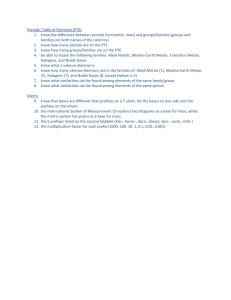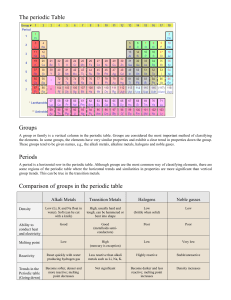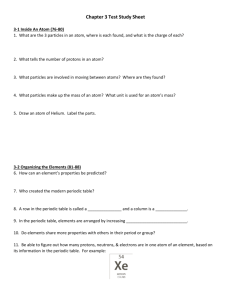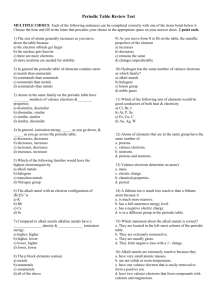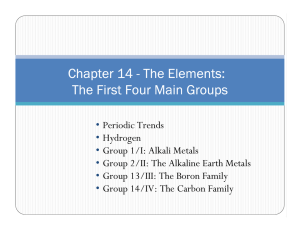Chemistry Study Guide & Vocabulary List
advertisement
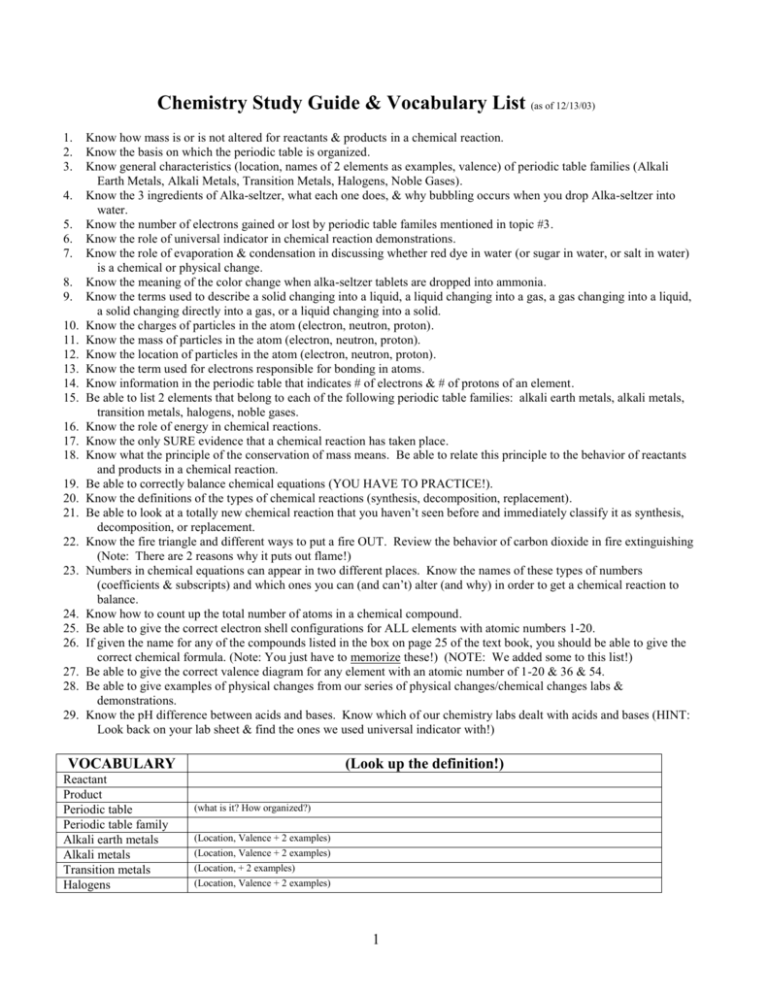
Chemistry Study Guide & Vocabulary List (as of 12/13/03) 1. 2. 3. 4. 5. 6. 7. 8. 9. 10. 11. 12. 13. 14. 15. 16. 17. 18. 19. 20. 21. 22. 23. 24. 25. 26. 27. 28. 29. Know how mass is or is not altered for reactants & products in a chemical reaction. Know the basis on which the periodic table is organized. Know general characteristics (location, names of 2 elements as examples, valence) of periodic table families (Alkali Earth Metals, Alkali Metals, Transition Metals, Halogens, Noble Gases). Know the 3 ingredients of Alka-seltzer, what each one does, & why bubbling occurs when you drop Alka-seltzer into water. Know the number of electrons gained or lost by periodic table familes mentioned in topic #3. Know the role of universal indicator in chemical reaction demonstrations. Know the role of evaporation & condensation in discussing whether red dye in water (or sugar in water, or salt in water) is a chemical or physical change. Know the meaning of the color change when alka-seltzer tablets are dropped into ammonia. Know the terms used to describe a solid changing into a liquid, a liquid changing into a gas, a gas changing into a liquid, a solid changing directly into a gas, or a liquid changing into a solid. Know the charges of particles in the atom (electron, neutron, proton). Know the mass of particles in the atom (electron, neutron, proton). Know the location of particles in the atom (electron, neutron, proton). Know the term used for electrons responsible for bonding in atoms. Know information in the periodic table that indicates # of electrons & # of protons of an element. Be able to list 2 elements that belong to each of the following periodic table families: alkali earth metals, alkali metals, transition metals, halogens, noble gases. Know the role of energy in chemical reactions. Know the only SURE evidence that a chemical reaction has taken place. Know what the principle of the conservation of mass means. Be able to relate this principle to the behavior of reactants and products in a chemical reaction. Be able to correctly balance chemical equations (YOU HAVE TO PRACTICE!). Know the definitions of the types of chemical reactions (synthesis, decomposition, replacement). Be able to look at a totally new chemical reaction that you haven’t seen before and immediately classify it as synthesis, decomposition, or replacement. Know the fire triangle and different ways to put a fire OUT. Review the behavior of carbon dioxide in fire extinguishing (Note: There are 2 reasons why it puts out flame!) Numbers in chemical equations can appear in two different places. Know the names of these types of numbers (coefficients & subscripts) and which ones you can (and can’t) alter (and why) in order to get a chemical reaction to balance. Know how to count up the total number of atoms in a chemical compound. Be able to give the correct electron shell configurations for ALL elements with atomic numbers 1-20. If given the name for any of the compounds listed in the box on page 25 of the text book, you should be able to give the correct chemical formula. (Note: You just have to memorize these!) (NOTE: We added some to this list!) Be able to give the correct valence diagram for any element with an atomic number of 1-20 & 36 & 54. Be able to give examples of physical changes from our series of physical changes/chemical changes labs & demonstrations. Know the pH difference between acids and bases. Know which of our chemistry labs dealt with acids and bases (HINT: Look back on your lab sheet & find the ones we used universal indicator with!) VOCABULARY Reactant Product Periodic table Periodic table family Alkali earth metals Alkali metals Transition metals Halogens (Look up the definition!) (what is it? How organized?) (Location, Valence + 2 examples) (Location, Valence + 2 examples) (Location, + 2 examples) (Location, Valence + 2 examples) 1 Noble gases Alka-seltzer Universal indicator Freezing Melting Vaporization Condensation Catalyst Enzyme Inhibitor Evaporation Atom Neutron Proton Electron Valence electrons Chemical symbol Chemical formula Chemical equation Coefficient Subscript Synthesis Decomposition Replacement Precipitate Activation energy Exothermic reaction Endothermic reaction Fuel Combustion Atomic number Cross-linked polymer Precipitate Sublimation Capillary action Formula for “water” Formula for “carbon dioxide” Formula for “methane” Formula for “rust” Formula for “hydrochloric acid” Formula for “ammonia” Formula for “sugar” Formula for “salt” Formula for “propane” Formula for “carbon monoxide” (Location, Valence + 2 examples) (location + charge) (location + charge) (location + charge) (define + give example) (define + give example) (define + give example) (define + give example) (define + give example) 2

